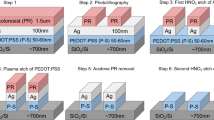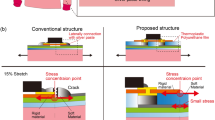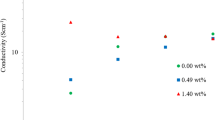Abstract
The thermocompression bonding of conductive polymer films was investigated to achieve a flexible wiring and packaging technique for organic and flexible electronics. Conductive polymer poly(3,4-ethylenedioxythiophene) polystyrene sulfonate (PEDOT:PSS) films were successfully bonded together by thermocompression even at rather low temperatures of 50–100 °C, especially through surface activation treatment using ultraviolet light irradiation. After thermocompression, the PEDOT:PSS films maintained their ohmic electrical conductivity even though the adhered interface had a contact resistivity of less than 1.3 Ω cm2. To examine the applications to electrical bonding, PEDOT:PSS patterns were fabricated on polyethylene naphthalate (PEN) substrates, and the bonding force after thermocompression was investigated. The adhesiveness of bonding was highly improved, and the films were strongly adhered at a bonding temperature of ~100 °C, which was lower than the glass transition temperature (Tg: 160 °C) of the PEN substrates. X-ray photoelectron spectroscopy (XPS) analysis of both the PEDOT:PSS and PEN surfaces and the attenuated total reflectance FT-IR (ATR-FT-IR) for the PEN surfaces indicated that the oxidized species of alcohol and carboxylate were generated after the surface activation process. These chemical species can form hydrogen bonds or covalent bonds that provide robust bonding interfaces.
This is a preview of subscription content, access via your institution
Access options
Subscribe to this journal
Receive 12 print issues and online access
$259.00 per year
only $21.58 per issue
Buy this article
- Purchase on Springer Link
- Instant access to full article PDF
Prices may be subject to local taxes which are calculated during checkout






Similar content being viewed by others
References
Cheng P, Zhan X, Yang Y. Next-generation organic photovoltaics based on non-fullerene acceptors. Nat Photonics. 2018;12:131–42.
Assadi M, Bakhoda S, Saidur R, Hanaei H. Recent progress in perovskite solar cells. Renew Sustain Energy Rev. 2018;81:2612–822.
Young O, Lee M, Park T, Jang H, Jeong A, Um M–K, Oh JH. Highly flexible chemical sensors based on polymer nanofiber field-effect transistors. J Phys Chem C Nanomater Interfaces. 2019;7:1525–31.
Li H, Shi W, Song J, Jang H–J, Dailey J, Yu J, Katz HE. Chemical and biomolecule sensing with organic field-effect transistors. Chem Rev. 2019;119:3–35.
Mensik M, Toman P, Bielecka U, Bartkowilk W, Pfleger J, Paruzel B. On the methodology of the determination of charge concentration dependent mobility from organic field-effect transistor characteristics. Phys Chem Chem Phys. 2018;20:2308–19.
Haase K, Rocha CT, Hauenstein C, Zheng Y, Hambsch M, Mannsfeld SCB. High‐mobility, solution‐processed organic field‐effect transistors from C8‐BTBT: polystyrene blends. Adv Electron Mater. 2018;4:1800076.
Hashimoto Y, Yamamoto T. Solid state direct bonding of polymers by vacuum ultraviolet light below 160 nm. Appl Surf Sci. 2017;419:319–27.
Truckenmuller R, Henzi P, Herrmann D, Saile V, Schomburg WK. Bonding of polymer microstructures by UV irradiation and subsequent welding at low temperatures. Microsyst Technol 2004;10:372–4.
Yamamoto T. Study on 172-nm vacuum ultraviolet light surface modifications of polydimethylsiloxane formicro/nanofluidic applications. Surf Interface Anal. 2011;43:1271–6.
Wu Q, Wei J, Xu B, Liu X, Wang H, Wang W, Wang Q, Liu W. A robust, highly stretchable supramolecular polymer conductive hydrogel with self-healability and thermo-processability. Sci Rep. 2017;7:41566.
Chen YJ, Yue TM, Guo ZN. A new laser joining technology for direct-bonding of metals and plastics. Mater Des. 2016;110:775–81.
Mathur A, Roy SS, Tweedie M, Mukhopadhyay S, Mitra SK, McLaughlin JA. Characterization of PMMA microfluidic channels and devices fabricated by hot embossing and sealed by direct bonding. Curr Appl Phys. 2009;9:1199.
Fu W, Shigetou A, Shoji S, Mizuno J. Low-temperature direct heterogeneous bonding of polyether ether ketone and platinum. Mater Sci Eng C Mater Biol Appl. 2017;79:860–5.
Yeh R-Y, Hsu R-Q. Improving the adhesion of plastic/metal direct bonding by injection moulding using surface modifications. Adv Mater Process Technol. 2016;2:21–30.
Huang B, Sun L, Li L, Zhang L, Lin Y, Che J. Experimental investigation of the strength of polymer-steel direct adhesion (PSDA) joints with micro-structures ablated by laser. J Mater Process Technol. 2017;249:407–14.
Alam A, Qin Y, Howlader M, Deen M. Direct bonding of liquid crystal polymer to glass. RSC Adv. 2016;6:107200–7.
Shinohara H, Mizuno J, Shoji S. Studies on low-temperature direct bonding of VUV, VUV/O3 and O2 plasma pretreated cyclo-olefin polymer. Sens Actuators A Phys. 2011;165:124–31.
Kim Y-J, Taniguchi Y, Murase K, Taniguchi Y. Vacuum ultraviolet-induced surface modification of cyclo-olefin polymer substrates for photochemical activation bonding. Appl Surf Sci. 2009;255:3648–54.
Bhattacharyya A, Klapperich CM. Mechanical and chemical analysis of plasma and ultraviolet–ozone surface treatments for thermal bonding of polymeric microfluidic devices. Lab Chip. 2007;7:876–82.
Wang C, Qi X, Wang Y, Wu B, Tian Y. Room-temperature direct heterogeneous bonding of glass and polystyrene substrates. J Electrochem Soc. 2018;165:B3091–7.
Yamamoto T. Solid-state bonding of silicone elastomer to glass by vacuum oxygen plasma, atmospheric plasma, and vacuum ultraviolet light treatment. Surf Interface Anal. 2013;45:817–22.
Bolto BA, McNeill R, Weiss DE. Electronic conduction in polymers. III. Electronic properties of polypyrrole. Aust J Chem. 1963;16:1090–103.
Shi H, Liu C, Jiang Q, Xu J. Effective approaches to improve the electrical conductivity of PEDOT:PSS: a review. Adv Electron Mater. 2015;1:1500017.
Nitani M, Nakayama K, Maeda K, Omori M, Uno M. Organic temperature sensors based on conductive polymers patterned by a selective-wetting method. Org Electron. 2019;71:164–8.
Culebras M, Gomez CM, Cantarero A. Thermoelectric measurements of PEDOT:PSS/expanded graphite composites. J Mater Sci. 2013;48:2855–60.
Zhou J, Anjum DH, Chen L, Xu X, Ventura IA, Jiang L, Lubineau G. The temperature-dependent microstructure of PEDOT/PSS films: insights from morphological, mechanical and electrical analyses. J Mater Chem C Mater. 2014;2:9903–10.
Kirihara K, Wei Q, Mukaida M, Ishida T. Reduction of specific contact resistance between the conducting polymer PEDOT:PSS and a metal electrode by addition of a second solvent during film formation and a post-surface treatment. Synth Met. 2018;246:289–96.
Kirihara K, Wei Q, Mukaida M, Ishida T. Thermoelectric power generation using nonwoven fabric module impregnated with conducting polymer PEDOT:PSS. Synth Met. 2017;225:41–8.
Nagata T, Oh S, Chikyow T, Wakayama Y. Effect of UV–ozone treatment on electrical properties of PEDOT:PSS film. Org Electron. 2011;12:279–84.
Takano T, Masunaga H, Fujiwara A, Okuzaki H, Sasaki T. PEDOT nanocrystal in highly conductive PEDOT:PSS polymer films. Macromolecules. 2012;45:3859–65.
Acknowledgements
This work was financially supported by the New Energy and Industrial Technology Development Organization (NEDO) and the Japan Science and Technology Agency (JST) as part of the Matching Planner Program.
Author information
Authors and Affiliations
Corresponding author
Ethics declarations
Conflict of interest
The authors declare that they have no conflict of interest.
Additional information
Publisher’s note Springer Nature remains neutral with regard to jurisdictional claims in published maps and institutional affiliations.
Supplementary information
Rights and permissions
About this article
Cite this article
Maeda, K., Nitani, M. & Uno, M. Thermocompression bonding of conductive polymers for electrical connections in organic electronics. Polym J 52, 405–412 (2020). https://doi.org/10.1038/s41428-019-0294-0
Received:
Revised:
Accepted:
Published:
Issue Date:
DOI: https://doi.org/10.1038/s41428-019-0294-0
This article is cited by
-
Sum frequency generation imaging for semi-crystalline polymers
Polymer Journal (2022)



